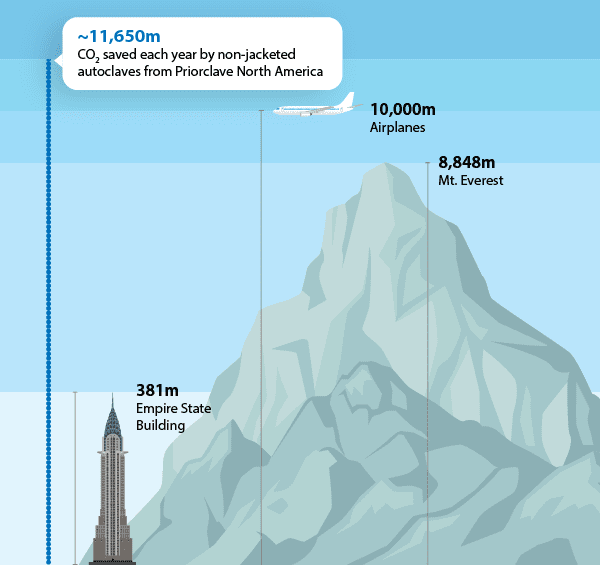Improving the Sustainability Scorecard in North American Labs
By: Priorclave North America
Category: News

At Priorclave North America, our goal is to make a difference. Specifically, we want to reduce labs’ environmental consequences—which can be startlingly high—while making it easier to get important work done on a daily basis.
It’s one thing to aspire to a sustainable system; it’s quite another to quantify the potential real-world savings of an environmentally efficient lab. So, recently we’ve begun working to do just that.
By the Numbers: Autoclave Water Consumption in the Lab
When it comes to autoclave efficiency, design is the key factor: a steam-jacketed autoclave is often somewhat faster than a non-jacketed model, but to achieve that speed, they use far more water and electricity. This is the entire reason Priorclave (a London-based company) has a North American division: to bring the efficiencies of Priorclave non-jacketed research autoclaves “across the pond.”
Among our most popular models is the EH320, a 320-liter workhorse for research labs. Presuming a lab with an EH320 runs one sterilization cycle per day during the workweek, its autoclave consumes around 3,640 gallons of water each year. By comparison, the two most popular same-sized jacketed autoclaves would use around 15,000 gallons each year, running the same number of cycles. More importantly, these jacketed autoclaves would use an additional 60,000 and 90,000 gallons even while sitting idle. An idle Priorclave uses no water at all.
Right now, there are 44 EH320s installed in our region. In the next year, those sterilizers will collectively save approximately 491,920 gallons of water while running cycles, and an additional 3.3 million gallons of water sitting idle. That’s roughly equivalent to a twelve-foot-deep swimming pool the size of a football field—enough clean water to meet the needs of more than 20,000 people.
By the Numbers: Autoclave Energy Efficiency in the Lab
While clean water is a major issue, it’s far from the biggest issue. Most labs and manufacturers rightfully worry about their carbon footprint, mostly due to energy consumption.
The average installed PNA EH320 consumes around 15kWh to run a standard cycle. In theory, its jacketed counterpart might use as little as 20 to 30kWh to do the same job. But, in practice, that isn’t the case. Most jacketed autoclaves “idle hot”: in addition to using water while sitting idle, they also consume electricity to maintain a head of steam. In real-world plug-load audits, universities have often found that while their Priorclaves use around 16kWh/day, their jacketed autoclaves consume closer to 80 to 90 kWh over the same period.
In the same year that a single EH320 saves its lab around 86,000 gallons of water, it also saves 18,200 kWh of electricity. For context, according to the U.S. Energy Information Administration, the average U.S. home uses 10,791 kWh per year. The average person living in southern African countries (excluding South Africa) uses 350 kWh per year.
The 44 currently installed EH320s save more than 800,000 kWh total—enough power to desalinate almost 70 million gallons of saltwater, converting it to potable water. It also means 685,000 fewer pounds of carbon dioxide pumped into our atmosphere.
Maintain Productivity; Use Fewer Resources
Remember: Each of the labs which have chosen an EH320 over a steam-jacketed autoclave are getting just as much work done each year—they just do so while consuming fewer resources, and saving enough energy and water to sustain tens of thousands of people living in the Global South.
And that’s just one year and one model. We have EH320s in the field that have been running for the last decade. Since 2011, Priorclave has sold around 300 non-jacketed autoclaves throughout North America, South America, and the Caribbean. Of those, 183 have been free-standing (i.e., non-benchtop) autoclaves. These are the models that, in our experience, would otherwise be steam jacketed. Taken together, Priorclave autoclaves currently installed in North America save labs around 3,000 MWh of energy per year, sparing the atmosphere 2,570,000 pounds of carbon dioxide—an impact equivalent to taking 250 cars off the road, or 1,705 people entirely giving up beef.
Priorclave North America is committed to providing educators, researchers, and innovators around the globe with the reliable, efficient, safe, affordable equipment you deserve. Are you ready to make your lab more efficient? Reach out to Priorclave North America today—let our autoclave experts answer your questions and set you on the path to sustainability.

A metric ton of gaseous CO2 at standard temperature and pressure would form a sphere roughly 10 meters tall (image source)

If you gathered all of the CO2 Priorclave non-jacketed autoclaves keep out of the atmosphere each year into one ton spheres and stacked them, the stack would be taller than Mt Everest and reach higher than the cruising altitude of commercial passenger jets.

